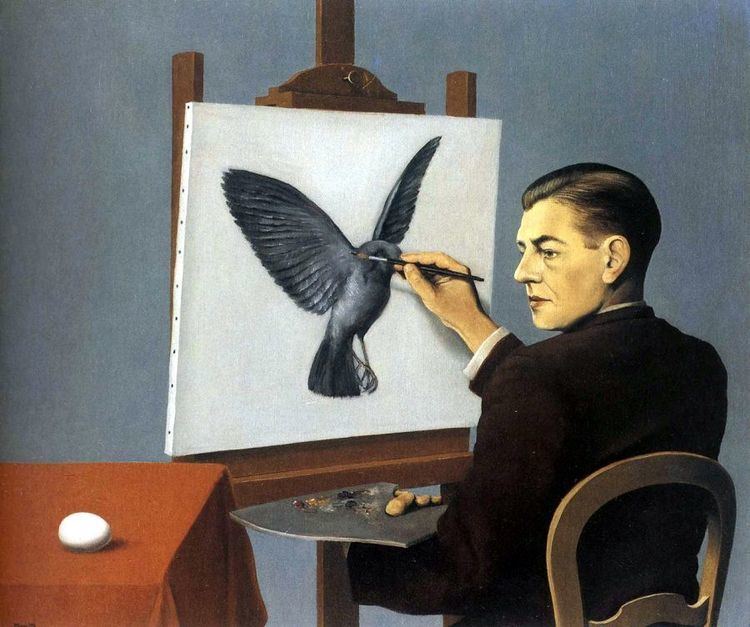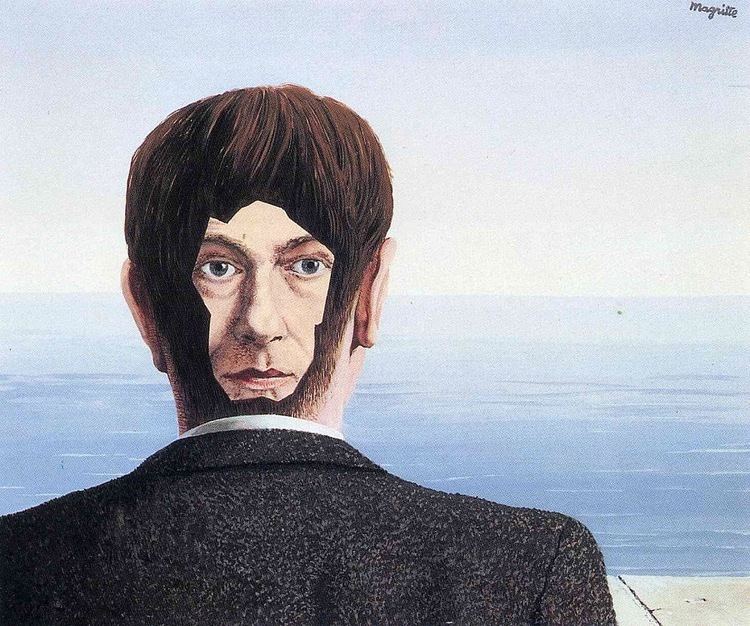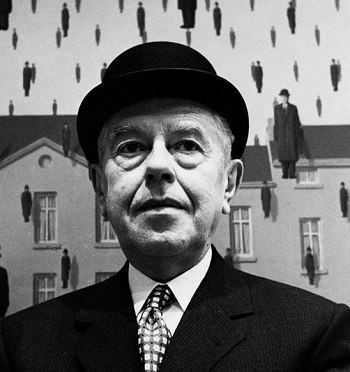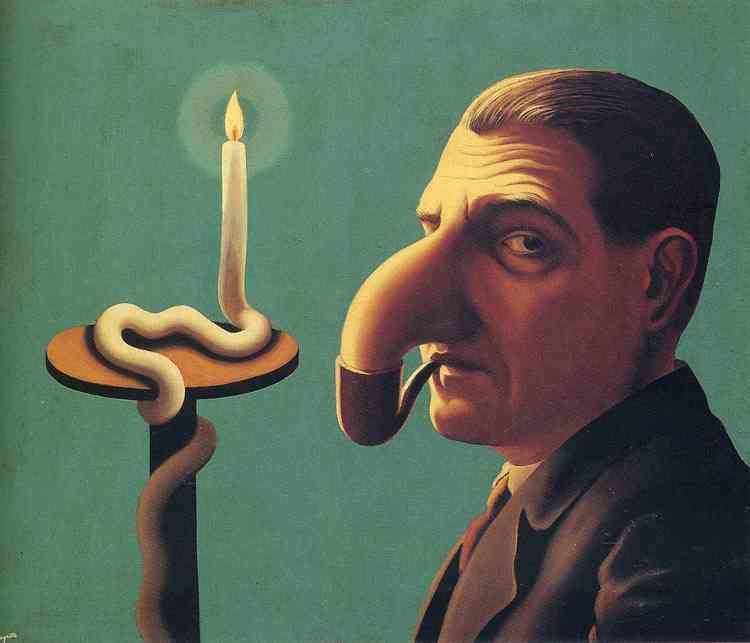Role Artist Known for Painter Fields Painting | Movies La fidelite des images Name Rene Magritte | |
 | ||
Full Name Rene Francois Ghislain Magritte Notable work The Treachery of ImagesOn the Threshold of LibertyThe Son of ManThe Human ConditionElective AffinitiesThe PortraitGolcondaThe Menaced Assassin Artwork Similar People | ||
Rene magritte 1898 1967 l empire des images france culture une vie une oeuvre
René François Ghislain Magritte ([ʁəne fʁɑ̃swa ɡilɛ̃ maɡʁit]; 21 November 1898 – 15 August 1967) was a Belgian surrealist artist. He became well known for a number of witty and thought-provoking images. Often depicting ordinary objects in an unusual context, his work is known for challenging observers' preconditioned perceptions of reality. His imagery has influenced pop, minimalist and conceptual art.
Contents
- Rene magritte 1898 1967 l empire des images france culture une vie une oeuvre
- Art with mati and dada ren magritte kids animated short stories in english
- Early life
- Career
- Personal life
- Philosophical and artistic gestures
- Artists influenced by Magritte
- In popular culture
- Magritte Museum
- Quotes
- References

Art with mati and dada ren magritte kids animated short stories in english
Early life

René Magritte was born in Lessines, in the province of Hainaut, Belgium, in 1898. He was the oldest son of Léopold Magritte, a tailor and textile merchant, and Régina (née Bertinchamps), who was a milliner before she got married. Little is known about Magritte's early life. He began lessons in drawing in 1910. On 12 March 1912, his mother committed suicide by drowning herself in the River Sambre. This was not her first attempt at taking her own life; she had made many over a number of years, driving her husband Léopold to lock her into her bedroom. One day she escaped, and was missing for days. Her body was later discovered a mile or so down the nearby river.

According to a legend, 13-year-old Magritte was present when her body was retrieved from the water, but recent research has discredited this story, which may have originated with the family nurse. Supposedly, when his mother was found, her dress was covering her face, an image that has been suggested as the source of several of Magritte's paintings in 1927–1928 of people with cloth obscuring their faces, including Les Amants.
Career

Magritte's earliest paintings, which date from about 1915, were Impressionistic in style. From 1916 to 1918, he studied at the Académie Royale des Beaux-Arts in Brussels, under Constant Montald, but found the instruction uninspiring. The paintings he produced during the years 1918–1924 were influenced by Futurism and by the figurative Cubism of Metzinger. In 1922, Magritte married Georgette Berger, whom he had met as a child in 1913. From December 1920 until September 1921, Magritte served in the Belgian infantry in the Flemish town of Beverlo near Leopoldsburg. In 1922–23, he worked as a draughtsman in a wallpaper factory, and was a poster and advertisement designer until 1926, when a contract with Galerie 'Le Centaure' in Brussels made it possible for him to paint full-time. In 1926, Magritte produced his first surreal painting, The Lost Jockey (Le jockey perdu), and held his first exhibition in Brussels in 1927. Critics heaped abuse on the exhibition. Depressed by the failure, he moved to Paris where he became friends with André Breton and became involved in the surrealist group. The illusionistic, dream-like quality is characteristic of Magritte's version of Surrealism. He became a leading member of the movement, and remained in Paris for three years.
Galerie 'Le Centaure' closed at the end of 1929, ending Magritte's contract income. Having made little impact in Paris, Magritte returned to Brussels in 1930 and resumed working in advertising. He and his brother, Paul, formed an agency which earned him a living wage. In 1932 he joined the Communist Party, which he would periodically leave and rejoin for several years.

During the early stages of his career, the British surrealist patron Edward James allowed Magritte to stay rent free in his London home and paint. James is featured in two of Magritte's works painted in 1937, Le Principe du Plaisir (The Pleasure Principle) and La Reproduction Interdite, a painting also known as Not to be Reproduced.
During the German occupation of Belgium in World War II he remained in Brussels, which led to a break with Breton. He briefly adopted a colorful, painterly style in 1943–44, an interlude known as his "Renoir Period", as a reaction to his feelings of alienation and abandonment that came with living in German-occupied Belgium. In 1946, renouncing the violence and pessimism of his earlier work, he joined several other Belgian artists in signing the manifesto Surrealism in Full Sunlight. During 1947–48, Magritte's "Vache Period", he painted in a provocative and crude Fauve style. During this time, Magritte supported himself through the production of fake Picassos, Braques and Chiricos—a fraudulent repertoire he was later to expand into the printing of forged banknotes during the lean postwar period. This venture was undertaken alongside his brother Paul Magritte and fellow Surrealist and 'surrogate son' Marcel Mariën, to whom had fallen the task of selling the forgeries. At the end of 1948, he returned to the style and themes of his prewar surrealistic art.
His work was exhibited in the United States in New York in 1936 and again in that city in two retrospective exhibitions, one at the Museum of Modern Art in 1965, and the other at the Metropolitan Museum of Art in 1992.
Politically, Magritte stood to the left, and retained close ties to the Communist Party, even in the post-war years. However, he was critical of the functionalist cultural policy of the communist left, stating that "Class consciousness is as necessary as bread; but that does not mean that workers must be condemned to bread and water and that wanting chicken and champagne would be harmful. (...) For the Communist painter, the justification of artistic activity is to create pictures that can represent mental luxury". While remaining committed to the political left, he thus advocated a certain autonomy of art. On his religious views, Magritte was an agnostic.
Popular interest in Magritte's work rose considerably in the 1960s, and his imagery has influenced pop, minimalist and conceptual art. In 2005 he came 9th in the Walloon version of De Grootste Belg (The Greatest Belgian); in the Flemish version he was 18th.
Personal life
Magritte married Georgette Berger in June 1922. Georgette was daughter of a butcher in Charleroi and had first met Magritte when she was only 13. They met again in Brussels in 1920 and Georgette subsequently became Magritte's model and muse. In 1936 Magritte's marriage got into trouble when he met a young artist, Sheila Legge, and began an affair. Magritte arranged for his friend, Paul Colinet, to entertain and distract Georgette, but this led to an affair between his wife and Colinet. Magritte and his wife did not reconcile until 1940.
Magritte died of pancreatic cancer on 15 August 1967, aged 68, and was interred in Schaerbeek Cemetery, Evere, Brussels.
Philosophical and artistic gestures
Magritte's work frequently displays a collection of ordinary objects in an unusual context, giving new meanings to familiar things. The use of objects as other than what they seem is typified in his painting, The Treachery of Images (La trahison des images), which shows a pipe that looks as though it is a model for a tobacco store advertisement. Magritte painted below the pipe "Ceci n'est pas une pipe" ("This is not a pipe"), which seems a contradiction, but is actually true: the painting is not a pipe, it is an image of a pipe. It does not "satisfy emotionally"—when Magritte was once asked about this image, he replied that of course it was not a pipe, just try to fill it with tobacco.
Magritte used the same approach in a painting of an apple: he painted the fruit and then used an internal caption or framing device to deny that the item was an apple. In these "Ceci n'est pas" works, Magritte points out that no matter how naturalistically we depict an object, we never do catch the item itself.
Among Magritte's works are a number of surrealist versions of other famous paintings. Elsewhere, Magritte challenges the difficulty of artwork to convey meaning with a recurring motif of an easel, as in his The Human Condition series (1933, 1935) or The Promenades of Euclid (1955) (wherein the spires of a castle are "painted" upon the ordinary streets which the canvas overlooks). In a letter to André Breton, he wrote of The Human Condition that it was irrelevant if the scene behind the easel differed from what was depicted upon it, "but the main thing was to eliminate the difference between a view seen from outside and from inside a room." The windows in some of these pictures are framed with heavy drapes, suggesting a theatrical motif.
Magritte's style of surrealism is more representational than the "automatic" style of artists such as Joan Miró. Magritte's use of ordinary objects in unfamiliar spaces is joined to his desire to create poetic imagery. He described the act of painting as "the art of putting colors side by side in such a way that their real aspect is effaced, so that familiar objects—the sky, people, trees, mountains, furniture, the stars, solid structures, graffiti—become united in a single poetically disciplined image. The poetry of this image dispenses with any symbolic significance, old or new."
René Magritte described his paintings as "visible images which conceal nothing; they evoke mystery and, indeed, when one sees one of my pictures, one asks oneself this simple question, 'What does that mean?'. It does not mean anything, because mystery means nothing either, it is unknowable."
Magritte's constant play with reality and illusion has been attributed to the early death of his mother. Psychoanalysts who have examined bereaved children have hypothesized that Magritte's back and forth play with reality and illusion reflects his "constant shifting back and forth from what he wishes—'mother is alive'—to what he knows—'mother is dead' ".
Artists influenced by Magritte
Contemporary artists have been greatly influenced by René Magritte's stimulating examination of the fickleness of images. Some artists who have been influenced by Magritte's works include John Baldessari, Ed Ruscha, Andy Warhol, Jasper Johns, Jan Verdoodt, Martin Kippenberger, Duane Michals and Storm Thorgerson. Some of the artists' works integrate direct references and others offer contemporary viewpoints on his abstract fixations.
Magritte's use of simple graphic and everyday imagery has been compared to that of the Pop artists. His influence in the development of Pop art has been widely recognized, although Magritte himself discounted the connection. He considered the Pop artists' representation of "the world as it is" as "their error", and contrasted their attention to the transitory with his concern for "the feeling for the real, insofar as it is permanent." The 2006–2007 LACMA exhibition "Magritte and Contemporary Art: The Treachery of Images" examined the relationship between Magritte and contemporary art.
In popular culture
The 1960s brought a great increase in public awareness of Magritte's work. Thanks to his "sound knowledge of how to present objects in a manner both suggestive and questioning", his works have been frequently adapted or plagiarized in advertisements, posters, book covers and the like. Examples include album covers such as Beck-Ola by The Jeff Beck Group (reproducing Magritte's The Listening Room), Alan Hull's 1972 album Pipedream which used The Philosopher's Lamp, Jackson Browne's 1974 album Late for the Sky, with artwork inspired by The Empire of Light, Oregon's album Oregon referring to Carte Blanche, the Firesign Theatre's album Just Folks... A Firesign Chat based on The Mysteries of the Horizon, and Styx's album The Grand Illusion incorporating an adaptation of the painting The Blank Check. The Nigerian rapper Jesse Jagz's 2014 album Jagz Nation Vol. 2: Royal Niger Company has cover art inspired by Magritte's works. In 2015 the band Punch Brothers used The Lovers as the cover of their album The Phosphorescent Blues.
The logo of Apple Corps, The Beatles' company, is inspired by Magritte's Le Jeu de Mourre, a 1966 painting.
Paul Simon's song "Rene and Georgette Magritte with Their Dog after the War", inspired by a photograph of Magritte by Lothar Wolleh, appears on the 1983 album Hearts and Bones.
John Cale wrote a song titled "Magritte". The song appears on the 2003 album HoboSapiens.
Tom Stoppard has written a surrealist play called After Magritte.
John Berger scripted the book Ways of Seeing using images and ideologies regarding Magritte. Douglas Hofstadter's book Gödel, Escher, Bach uses Magritte works for many of its illustrations. The Treachery of Images was used in a major plot in L. J. Smith's The Forbidden Game.
Magritte's imagery has inspired filmmakers ranging from the surrealist Marcel Mariën to mainstream directors such as Jean-Luc Godard, Alain Robbe-Grillet, Bernardo Bertolucci, Nicolas Roeg, John Boorman and Terry Gilliam.
According to Ellen Burstyn, in the 1998 documentary The Fear of God: 25 Years of "The Exorcist", the iconic poster shot for the film The Exorcist was inspired by Magritte's L'Empire des Lumières.
In the 1992 movie Toys, Magritte's work was influential in the entire movie but specifically in a break-in scene, featuring Robin Williams and Joan Cusack in a music video hoax. Many of Magritte's works were used directly in that scene.
Gary Numan's 1979 album The Pleasure Principle was a reference to Magritte's painting of the same name.
Magritte Museum
The Magritte Museum opened to the public on 30 May 2009 in Brussels. Housed in the five-level neo-classical Hotel Altenloh, on the Place Royale, it displays some 200 original Magritte paintings, drawings and sculptures including The Return, Scheherazade and The Empire of Lights. This multidisciplinary permanent installation is the biggest Magritte archive anywhere and most of the work is directly from the collection of the artist's widow, Georgette Magritte, and from Irene Hamoir Scutenaire, who was his primary collector. Additionally, the museum includes Magritte's experiments with photography from 1920 on and the short surrealist films he made from 1956 on.
Another museum is located at 135 Rue Esseghem in Brussels in Magritte's former home, where he lived with his wife from 1930 to 1954. A painting, Olympia (1948), a nude portrait of Magritte's wife by Magritte, was stolen from this museum on the morning of 24 September 2009 by two armed men. The stolen work is said to be worth about US$1.1 million. Olympia was returned to the museum early January 2012. The thieves handed back the painting because they were unable to sell it on the black market due to its fame.
Quotes
Everything we see hides another thing - we always want to see what is hidden by what we see
If the dream is a translation of waking life - waking life is also a translation of the dream
The mind loves the unknown It loves images whose meaning is unknown - since the meaning of the mind itself is unknown
